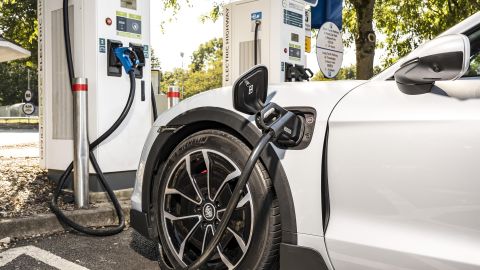EU to get EV fast chargers at every 37 miles on major roads
Determined to make life easier for EV drivers, the Council of the European Union (CEU) has announced the adoption of a new set of rules that includes a law that mandates installation of fast charging stations at a distance of every 37 miles (60 km) along the trans-European transport (TEN-T) network. The new law states that EU members states will be responsible for installing fast charging stations of at least 150 kilowatts (kW) for electric cars and vans along the TEN-T network starting year 2025. Furthermore, the law mandates that the charging stations placed along the roads linking major cities and nodes will have to be capable of delivering a total output of at least 400 kW, including at least one charging point capable of delivering at least 150 kW individually.
By the end of 2027, each of the charging stations will be required to extend its total power to 600 kW, while the individual stall of at least 150 kW power will remain unchanged.
The new law also mandates that EV fast chargers installed on the TEN-T network must allow payment without subscriptions as that would make it easier for EV drivers to get their vehicles recharged at any charging station along the network. By the mid of next decade, charging stations on the TEN-T comprehensive road network will be required to deliver a combined power of at least 600 kW, while the number of stalls capable of delivering at least 150 kW must not be less than two.
Charging network operators must provide consumers with full information through electronic means on the availability, waiting time as well as price at different stations along the major road network.
Spanish Minister of Transport, Raquel Sánchez Jiménez, expressed optimism that consumers will be able to charge their EVs as easily in the near future as they do today at traditional petrol stations.
Speaking on the topic, Jimenez said, “The new law is a milestone of our ‘Fit for 55’ policy providing for more public recharging capacity on the streets in cities and along the motorways across Europe. We are optimistic that in the near future, citizens will be able to charge their electric cars as easily as they do today in traditional petrol stations.”
Adoption of the new law is part of the EU’s “Fit for 55” package of initiatives that amins to trim down greenhouse gas emissions by 55 per cent by the end of current decade (2030), compared to the levels recorded in 1990.
Europe has been slow in adopting clean energy. While EU authorities have been talking about reduction in dependence on fossil fuels, the market share of renewable energy is quite low. Many automobile industry and environment expert argue how good it is to power electric cars with fossil-fuel generated electricity. The primary sources of electricity generation in Europe are as follows:
Fossil Fuels: Historically, fossil fuels have been the dominant source of electricity in Europe. Coal, natural gas, and oil are burned in power plants to produce steam, which drives turbines connected to electricity generators. However, due to environmental concerns and efforts to reduce greenhouse gas emissions, many European countries have been gradually reducing their reliance on fossil fuels in favor of cleaner energy sources.
Nuclear Power: Nuclear power is another significant source of electricity in Europe. Nuclear power plants use controlled nuclear reactions to produce heat, which, in turn, generates steam to drive turbines. Countries like France and Sweden have a substantial share of their electricity generation coming from nuclear power.
Renewable Energy Sources:
Europe has been steadily increasing its capacity for renewable energy production. The main renewable sources used for electricity generation include:
a. Wind Power: Onshore and offshore wind farms harness the kinetic energy of the wind to turn turbines and produce electricity. Countries like Germany, Denmark, the United Kingdom, and Spain are prominent users of wind power.
b. Solar Power: Solar panels capture sunlight and convert it into electricity through the photovoltaic effect. Countries like Germany, Italy, and Spain have invested heavily in solar energy installations.
c. Hydropower: Rivers and dams are used to generate hydroelectric power. Norway, Sweden, and Switzerland are notable for their significant hydroelectric capacity.
d. Biomass: Organic materials such as wood, agricultural residues, and organic waste can be burned to generate electricity. Biomass power plants are common in various European countries.
Geothermal Energy:
Some regions in Europe have access to geothermal energy, where heat from the Earth's crust is used to produce electricity. Iceland, for example, relies heavily on geothermal power.
Interconnections:
Europe has a well-developed electricity grid that allows for cross-border electricity trading and cooperation. Countries can import and export electricity to balance supply and demand, optimize resource usage, and enhance energy security.
It is essential to note that the energy landscape is continually evolving, and the mix of electricity generation sources in Europe have been changing. The transition is slow.
The video compares different fast charger networks in the United States.
